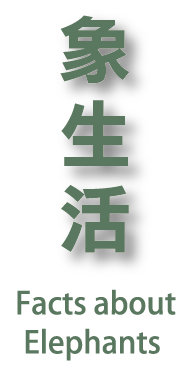怎麼取食?
How Does an Elephant Eat?
靈活的鼻子
Agility of the Elephant’s Trunk
人類有手及指頭,可以拿取食物等物品並且靈巧工作,大象沒有手,但牠們有靈活的鼻子。象鼻結合了鼻子與上唇,沒有任何骨頭或軟骨,由約4萬條左右的肌肉組成,鼻子長到可以接觸到地面,因此大象可以伸長象鼻摘取樹上的樹葉果實或是拔起地面的嫩草再捲入嘴巴。
象鼻的末端有突起,就像人類的指頭一樣,幫助大象用來夾或勾,拿取像花生般大小的食物。此外,象鼻突起處有敏感的神經,能感應外界訊息,再傳遞至大腦。
Humans are endowed with hands agile enough to grasp food and perform complex tasks. Elephants though rely on the agility of their trunks. The trunk functions as both their nose and their upper lip. The trunk has no bones or cartilages but instead is made of approximately 40,000 muscles and is long enough to pick grass off the ground and reach for leaves and fruits on trees.
Elephants curl their trunks to bring food to their mouths. At the tip of the trunk is a finger-like protrusion that is able to pinch and to hook, allowing elephants to pick up food the size of a peanut. The protrusion has sensitive nerves, making the trunk a sensor that sends information about the environment to the brain.


延伸小知識 Extended knowledge
大象的鼻子為什麼這麼長? Why is the trunk so long?
因為大象每天需要大量進食以維持身體所需要的能量,所以象頭有著大嘴和不斷磨碎食物的大牙齒,因此象頭又大又重,只能以粗壯的短脖子來支撐頭部,加上3-4公尺的身高,要低頭喝水或吃地上的草就變成了苦差事。於是大象發展出又長又靈活的象鼻,像我們的手一樣幫助牠拿取地上的食物,又像吸管將水吸取後送進嘴裡享用。
This is because elephants require large amounts of food on a daily basis to maintain their body’s metabolism. Therefore, the elephant boasts a huge mouth and large teeth to grind and tear their food. Due to the immense size and weight of its head, elephants require a stout, short and muscular neck as a support. Given its body height anywhere between 3 to 4 meters, it makes it quite challenging for the elephant to lower its head to feed off grass on the ground or drink water. As a result, the elephant developed a long and dexterous trunk through evolution, which allows it to grab food from the surface – just like how we use our hand. It can also be used like a straw to transfer water into its mouth for drinking.
鼻子喝水還是嘴巴喝水
Do Elephants Drink Through Their Trunks?
象鼻就像大象自備的長吸管,但大象喝水並不是直接將水透過鼻子吸到食道,而是將水先吸附在鼻子的前端,再送入口中。大象一口氣可以吸5公升的水,因為體型龐大需要大量的水分,每天約需要100公升的水才足夠大象生活。
鼻子對大象而言是很重要的器官,可以呼吸、取東西、吸水、聞味道、感應外界訊息,還可以像喇叭般把叫聲傳出去。大大小小的事少不了象鼻,所以一旦象鼻受傷,就會對大象的生存造成莫大影響,大象會因為象鼻無法吸水或失去感覺功能而死亡。
While it’s tempting to think of the trunk as a long straw, elephants can’t pass water directly to the esophagus through their trunks. Rather, elephants hold water in the trunk before transferring it to their mouths. Elephant trunks can draw up to 5 liters of water into their trunks at one time. Because of their size, elephants need 100 liters of water daily.
The trunk is a vital organ for the elephant; it helps them breathe, grasp, drink, smell, and sense the environment. It can even make trumpet-like sounds for communication. Because of its critical functions, an injury to the trunk can eventually lead to an elephant’s death.
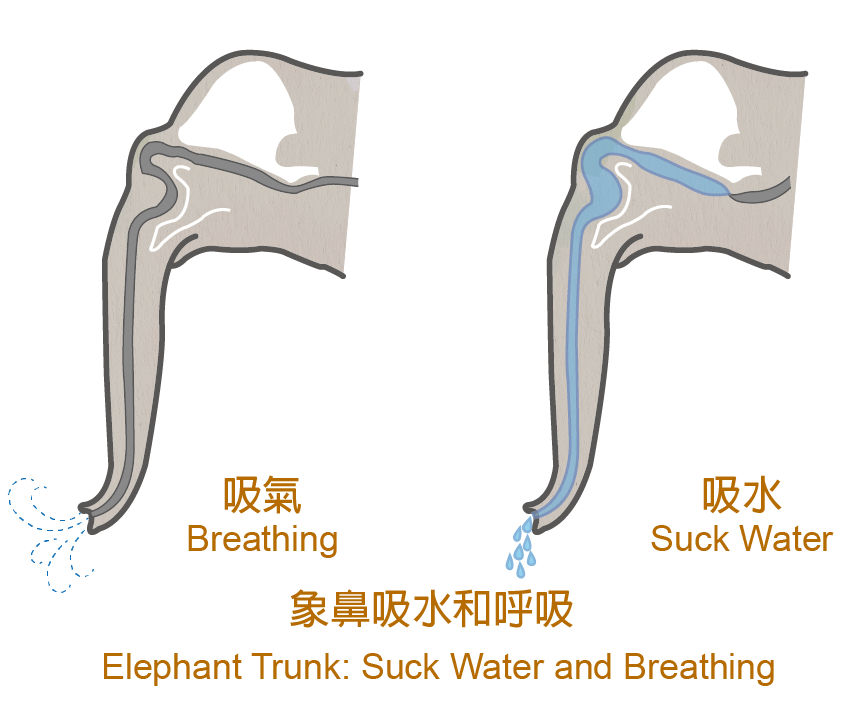
大象的氣管與食道相通,但鼻腔後面的食道上方有一塊像閥門的軟骨,當大象用鼻子噴出水時,軟骨會自動打開,又能正常呼吸了。
The elephant’s trachea is connected to its esophagus. However, behind the beast’s nasal cavity and above its esophagus, there is a cartilage which functions like a valve. Whenever the elephant pumps out water from its nose, the cartilage will automatically open, allowing it to breathe regularly again.
用嘴巴喝奶 Drinking milk Through the mouth
小象還小時不太會使用鼻子,沒辦法像大象喝水時,先將水吸附在鼻子前端,所以小象會將短短的鼻子向上捲起,直接用嘴吸吮母奶。
Before mastering the skill of drinking water with the trunk, infants first begin drinking milk from their mothers. They can curl up their short trunks and suckle with their mouths.
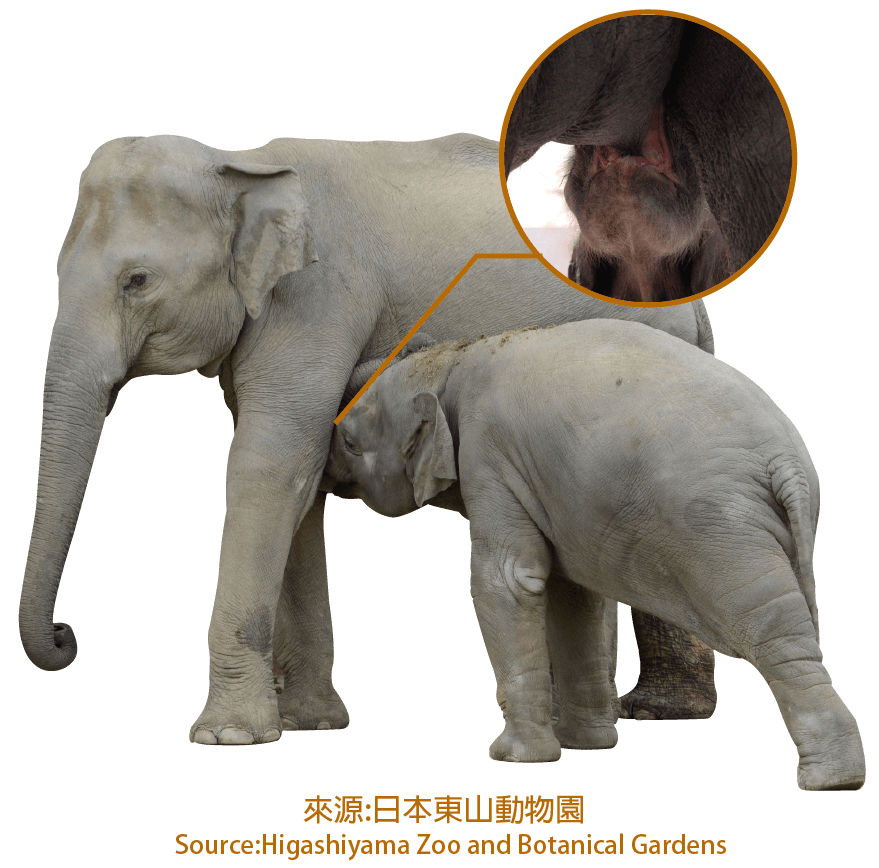
大象吃什麼?
What do Elephants Eat?
吃素吃樹
Elephants Eat from Trees
大象是標準的植食者動物,牠們只吃植物,青草、野果、樹葉、小樹枝都是牠們的食物,大象也會用象牙及象鼻撕下樹皮來填飽肚子。每天大約要吃150公斤以上的食物。
動物園的大象食物不同於野生象,主食以狼尾草為大宗,其他的有玉米、粒狀飼料、紅蘿蔔、地瓜、甘蔗、蘋果、香蕉、木瓜等。但為了牠們的身體健康,甘蔗和水果等甜份高的食物只能適量給予或當成訓練時的獎勵。
Elephants are typical herbivores. They eat grass, fruits, leaves, and small tree branches. Elephants also eat tree bark by removing it from the tree using their tusks and trunks. They need 150 kilograms of food per day.
Elephants in the zoo are also herbivores. Unlike elephants in the wild, the bulk of their diet consists of Pennisetum purpureum, along with supplements such as corn, pallet feeds, carrots, sweet potato, sugarcane, apple, banana, and papaya. To help keep elephants healthy, sugary foods like sugarcane and fruit are given in moderation, for example as a reward during training.
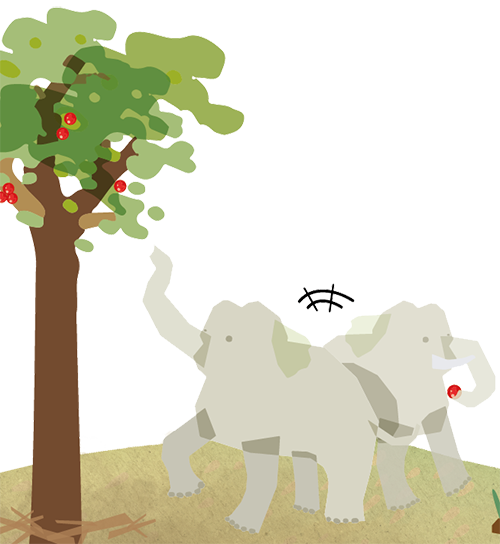
食物慢磨機
Elephants Are Slow Eaters
大象的食量大一年要吃掉50公噸的食物,吃的都是青草、樹葉、樹枝、樹皮等纖維較粗的食物,所以牙齒需要很強的咀嚼力,因此發展出高齒板數的臼齒。高齒板可以讓大象的臼齒不會很快被磨損。
食物在經過高齒板的上下臼齒間,就像被兩塊洗衣板研磨搓揉,加上斜向的研磨方式,增加咀嚼研磨面積,讓大象能更有效吸取食物之中的養分。
An elephant consumes 50 tons of food annually. With a diet comprising completely of materials with tough fibers such as grass, leaves, tree barks and branches, their teeth need to accommodate powerful chewing forces. As a result, high dental lamina is developed in their molars. The high dental lamina increases the tooth durability, slowing down wear and tear on the molars.
The molars grind food like a pair of washboards. The total chewing area is increased with the aid of lateral chewing actions that allow elephants to digest food more effectively.

推陳出新
Molar Replacement
大象的臼齒被食物磨久了也是會磨損,食量大的大象沒了臼齒可就無法進食,因此演化出五次換牙的機會,大象的臼齒替換方式與人類的不同,大象是以水平方向替換。大象的臼齒生長於臉頰內側的牙床,當前方的臼齒被磨損,後方的臼齒就會慢慢生長並向前推進,然後把前方臼齒擠掉,並取代其位置。
大象的臼齒是陸續長出,一生中上下左右各有6顆臼齒供替換,共有24顆臼齒,而且隨著年齡成長,臼齒會越來越大,齒板數目也會越來越多。第一、二顆臼齒在出生時長出,在一歲左右會長出第三顆臼齒,這三顆臼齒供大象年幼時期使用,第四顆到第六顆會陸續長出,第六顆也是最後一顆大約在25歲開始慢慢生長,大象的餘生就靠後面的三顆臼齒,當最後一顆臼齒也被磨損,大象便會因為無法進食而死亡。
Elephant molars eventually wear out. Without their teeth, elephants are unable to ingest food. Elephants have evolved the ability to replace their teeth five times over their lifespan. Unlike human teeth which are replaced vertically, elephant teeth are regenerated horizontally. Elephant molars grow inside the gums further back in the cheeks. When molars at the front wear out, new molars at the back push old molars forward until they fall out. Elephants grow molars continuously. Most elephants have a total of 24 sets of molars, 6 on each side in their lifespan. As an elephant matures, the size of its molars increases along with the number of lamina on each molar. The first and second molars are present at birth. Around the age of one, a third molar will develop. The third set of molars last through the elephant’s youth. Subsequently, the fourth, fifth and sixth molars appear. The sixth set of molars start to grow slowly around the age of 25; this would be the last set of molars in an elephant’s lifetime. When these wear out, the elephant will die from starvation.

延伸小知識 Extended Knowledge
象牙 Elephant Tusks
一般所熟知的「象牙」是大象上顎的門牙,終其一生都在生長。大象靠著門牙挖掘尋找地底下的水份、剝樹皮填飽肚子、遇到敵人攻擊示威用的武器,還可以讓象鼻暫時放著休息,因此,象牙對大象而言極其重要。
Tusks are actually teeth, the upper incisors on the upper jaw that grow continuously. Elephants use their tusks to find water in the ground, strip trees of their bark, and threaten and attack off enemies. Tusks can also serve as a place to hang a weary trunk as the elephant relaxes.
短眠的大象
Short Sleeping Elephants
躺著睡還是站著睡?
Do Elephants Sleep Standing Up or Lying Down?
大象每天需要吃大約150公斤的食物,牠們一天花費20小時以上的時間在覓食,因此沒有花太多時間在睡覺。對大象而言,與其花時間睡覺還不如花時間吃東西,可補充體力、維持身體機能。大象大部分是站著睡覺,這樣當牠們遇到危險時能快速醒來躲避危險,大象只有在走了很遠的路,周圍沒有危險的情況下,或是三到四天沒睡覺,才會躺下睡覺,睡眠時間大約1小時。
Elephants need 150 kilograms of food every day, so they spend over 20 hours a day foraging. This leaves little time for sleeping. Instead, an elephant’s time is better spent feeding. Foraging and eating replenishes the elephant’s strength and maintains its bodily functions. Most elephants sleep in a standing position that allows them to quickly wake up and flee from danger. Elephants only lie down to sleep in safe environments after lengthy hikes, or after being deprived of sleep for over 3 days. Even then, they sleep only for one hour at a time.

散熱法寶
Cooling Gadgets
皺巴巴的皮膚
Wrinkled Skin
人類隨著年紀的增長,皮膚會鬆弛而產生皺摺,而大象卻是從一出生全身的皮膚就皺巴巴的,這是因為要幫助大象散熱。天氣很熱的時候,大象會泡在泥巴池中,用象鼻把泥巴水往身上噴灑,透過皺皺的皮膚,保留水分在身上減緩蒸發,大象因此能涼爽久一點。大象在沙地將沙子甩到背上,利用沙子卡在皺褶的皮膚中,為大象的背覆蓋了一層保護,阻隔陽光直接照射,才不會熱昏頭。
Human skin wrinkles with age. Elephants, on the other hand, are born with wrinkly skin. Wrinkles help elephants dissipate heat. In hot weather, elephants soak themselves in mud baths, using their trunks to spray mud on their skin. Water held in wrinkles on the elephant’s skin evaporates more slowly and prolongs the cooling effect. Elephants spray sand on their back when on sandy land. Wrinkles help hold the sand in place to form a protective layer against direct exposure to the sun.

大扇子耳朵
Fan-Like Elephant Ears
大象跟大多數的大型哺乳動物不同,牠們不會排汗,當要發散身體多餘的熱時,牠們需要依靠巨大又扁平且布滿血管的耳朵,藉由耳朵微血管的收縮及舒張,控制進入耳朵血液的流量。因為大象耳朵的皮膚很薄,當血液經過耳朵時,大象搧動耳朵,讓冷空氣吹拂耳朵表面,降溫耳朵裡的血液,再將降溫的血液傳回身體各處,以冷熱交換機制達到身體降溫。
非洲象與亞洲象的耳朵大小不同與生活的棲地環境有關,因為非洲象生活的環境氣溫相對於亞洲象來的炎熱,因此非洲象相對於亞洲象需要較大的耳朵來散熱。
Unlike most mammals, elephants do not sweat. In order to shed excessive heat, elephants rely on ears filled with blood vessels. These blood vessels expand and contract to help regulate the amount of blood circulating through the ears, and because of the thin skin of the ear which lets the blood to be closer to the air, elephants can flap their ears to circulate air and cool the blood within. Cooler blood then circulates back to the rest of the elephant’s body, helping to lower their body temperature through heat exchange mechanism.
As a result of different environments, African elephants and Asian elephants have different ear sizes. Elephants in Africa live in warmer environments compared to elephants in Asia, and as a result have larger ears to help them dissipate more heat.

大象的耳朵皮膚很薄,可以看見血管分布。
Blood vessels are visible through the thin skin on the elephant ear.
延伸小知識 Extended Knowledge
大象的皮膚厚嗎? Are elephants thick-skinned?
象皮最厚的地方在背部,約2-3公分,最薄的地方在腹部,大約0.5公分。如果要比皮厚,相較於河馬的6公分,大象皮算是薄的了。
The thickest skin is on the back, at 2-3 cm. The thinnest skin is found on the belly, only 0.5 cm in thickness. Speaking of skin thickness, when compared to the hippopotamus’ skin that is 6 cm thick, the elephant’s skin is considered much thinner.
大象的家庭
Elephant Family Structure
男女大不同
Gender Differences
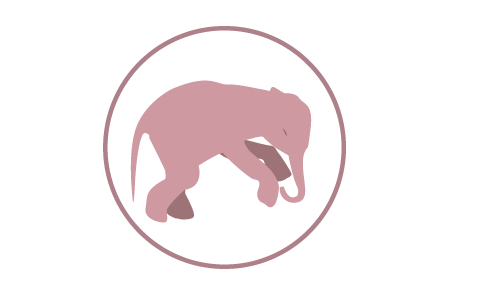
母象經過22個月的懷孕期,生下大象寶寶。
The elephant’s gestation period lasts 22 months.
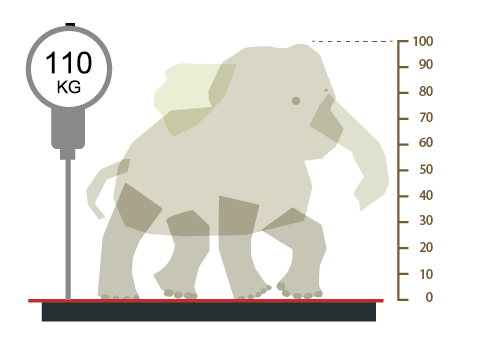
大象寶寶剛出生時大約70至110公斤,身高約90至100公分。
At birth, baby elephants weight between 70 and 110 kilograms and are 90 to 100 cm tall.

幼象會吸吮母奶直到2歲,2歲之後除了喝母奶,開始吃一些野外的食物,也會用象鼻在母象的口中取出食物。幼象到5至6歲才會完全斷奶。
They feed on mothers’ milk until the age of 2, and then begin to eat solid food. Around the same time, calves learn to grasp foods from their mother’s mouths. Elephants stop nursing at the age of 5 or 6.
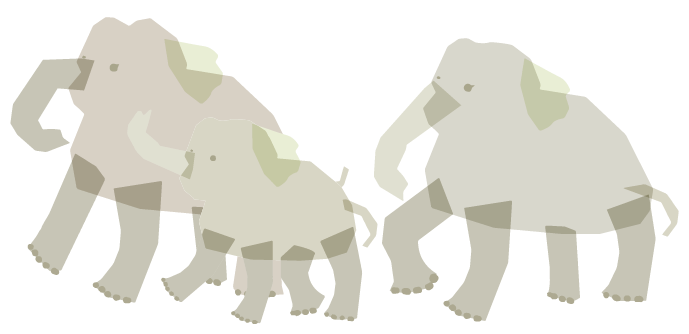
小象成長到10到15歲左右時進入性成熟期,母象會繼續留在象群裡,像小保母幫忙照顧新生小象;而公象會離開原本的象群,加入其他公象所組成的單身公象群,或是獨自生活。
Young elephants become sexually mature at the age between 10 and 15. Cows continue to live with the herd to care for other calves. Bulls, on the other hand, either join a group of bachelors, or live alone.
母系社會
Matriarchal Society
象群由母象、年輕的象及大象寶寶所組成,通常有6到20隻象,也有更龐大的象群。每個象群都由最年長的母象帶領,如果以人類的社會來比喻,領導的母象是外婆,家庭成員有媽媽、阿姨、姐姐。領導的母象負責教育及傳遞經驗,如指引覓食的路線,以及如何躲避危險;象群間的關係密切,總是集體行動,也會一同照顧小象寶寶幫忙哺乳。
Herds of are comprised of cows, juvenile elephants, and calves, and are led by a matriarch. Usually numbering 6-20 members, some herds exceed this number. The herd is a community comprised of a grandmother, mothers, aunties and big sisters. The matriarch is responsible for educating the young and passing on her experience and knowledge, such as foraging routes and dangers. Elephants in herds share a close bond. All cows share the responsibility of nursing and breastfeeding.

延伸小知識 Extended Knowledge
公象通常獨自生活,但在發情期間,會來到母象群的周遭,用象鼻聞氣味,尋找同樣處於發情期的母象,選中一隻母象與其交配然後離開。
Male elephants often live alone. When females are in heat, males approach herds using their trunks to sniff out cows that are ready to mate. After mating, the bull leaves the herd.
大象在講什麼?
What Are Elephants Saying?
象鼻語言
The Languages of Elephant Trunks
大象常用肢體的觸碰來表達各種語意,象鼻就是牠們最常使用的交流溝通工具,例如:兩隻大象把象鼻相互勾著,表示彼此打招呼;母象用象鼻撫摸小象表達關愛;年輕氣盛的公象象鼻纏繞,表示牠們正進行角力比賽。
Elephants often communicate through physical contact, with the trunk being the most important communication tool. For example, two elephants greet each other by intertwining their trunks, a mother uses her trunk to affectionately caress her calf, and young males get their trunks tangled as they wrestle.

象群堡壘
Elephant Herd Fortress
大象不只會用腳接收訊息,也會用象鼻聞周遭是否有同伴或是敵人,當大象嗅出周遭有危險時,會發出訊號通知同伴,同時最年長的母象會張開雙耳並發出吼叫聲嚇阻敵人,其他母象則會用身體將小象圍在中心,保護牠們的安全。
Besides receiving signals through their feet, elephants can also use their trunks to sniff out enemies in their environment. When elephants detect a threat, they send out alarms to alert the herd. The matriarch will fan out her ears and roar to intimidate the enemy. The other cows in the herd form a circle to protect the calves.

用腳接電話
Answering Phone Calls with a Foot
大象用身體不同部位來接收訊息和傳遞訊息,牠們用嘴巴和長鼻子來發出低吼、咆哮、還有喇叭般的叫聲相互對話。但距離較遠時,耳朵就無法接收到訊息,這時大象會發出低頻率的聲音,聲音透過地面傳播,在遠方的大象,利用腳底厚厚又柔軟的脂肪墊來感應地面的震動,藉此接收訊息。
Elephants use various body parts to communicate. Mouths and trunks can make sounds, but when outside audible range, elephants can create rumbling low frequency vibrations that can be felt through the ground. Elephants can sense these signals at a great distance through the soft cushions on their feet.
延伸小知識 Extended Knowledge
大象能發出超過70種聲音,高興時嘶喊、生氣時隆隆低鳴,透過不同的音高、發聲間隔等組合,形成不同的意義,例如有警告、呼喊同伴等不同聲音。
Elephants make over 70 sounds. They trumpet in joy and rumble to display anger. Different combinations of frequencies and tempos are used for various messages, such as warnings or getting the attention of a companion.

